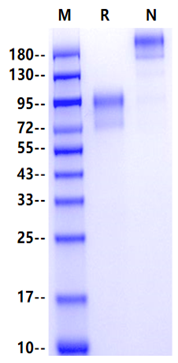Ser32-Thr290, with C-terminal Human IgG1 Fc SLDNNGTATPELPTQGTFSNVSTNVSYQETTTPSTLGSTSLHPVSQHGNEATTNITETTVKFTSTSVITSVYGNTNSSVQSQTSVISTVFTTPANVSTPETTLKPSLSPGNVSDLSTTSTSLATSPTKPYTSSSPILSDIKAEIKCSGIREVKLTQGICLEQNKTSSCAEFKKDRGEGLARVLCGEEQADADAGAQVCSLLLAQSEVRPQCLLLVLANRTEISSKLQLMKKHQSDLKKLGILDFTEQDVASHQSYSQKTIEGRMDPKSSDKTHTCPPCPAPELLGGPSVFLFPPKPKDTLMISRTPEVTCVVVDVSHEDPEVKFNWYVDGVEVHNAKTKPREEQYNSTYRVVSVLTVLHQDWLNGKEYKCKVSNKALPAPIEKTISKAKGQPREPQVYTLPPSRDELTKNQVSLTCLVKGFYPSDIAVEWESNGQPENNYKTTPPVLDSDGSFFLYSKLTVDKSRWQQGNVFSCSVMHEALHNHYTQKSLSLSPGK
1. Civin C.I. et al. (1984) J. Immunol. 133:157. 2. Katz F. et al. (1985) Leuk. Res. 9:191. 3. Andrews R.G. et al. (1986) Blood 67:842.
Cluster of Differentiation 34 (CD34) is a member of a family of single-pass transmembrane sialomucin proteins, and may function as a cell-cell adhesion factor by mediating the attachment of stem cells to the bone marrow extracellular matrix or directly to stromal cells. Could act as a scaffold for the attachment of lineage specific glycans, allowing stem cells to bind to lectins expressed by stromal cells or other marrow components. Presents carbohydrate ligands to selectins.CD34 protein is selectively expressed on hematopoietic progenitor cells and the small vessel endothelium of a variety of tissues. It has been widely used as a stem and progenitor cell marker, and clinical CD34+ stem cell transplantation (CD34+SCT) has been performed for tumor purging. CD34 monoclonal antibodies are widely used to identify and isolate hemopoietic progenitors and to classify acute and chronic leukemias.

1μg (R: reducing condition, N: non-reducing condition).